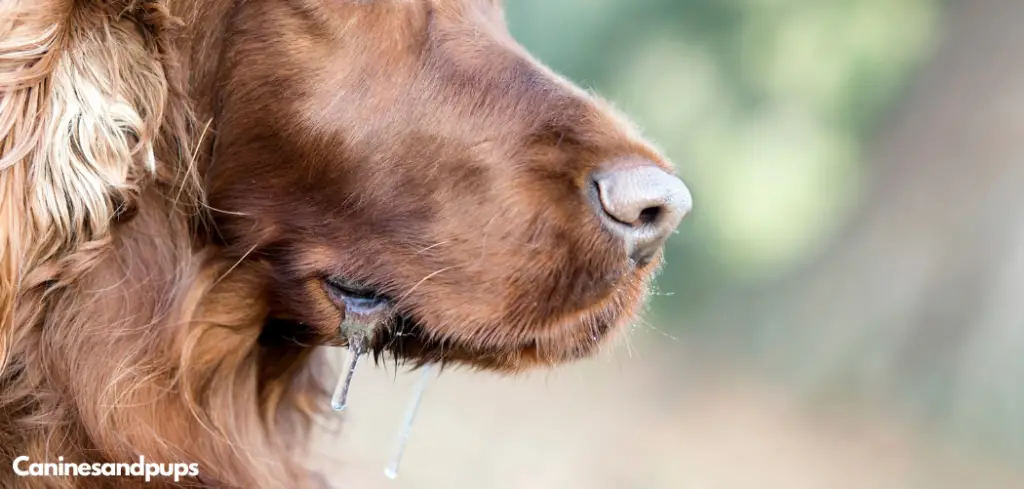If your dog drools excessively in the car, it can be stressful both for them and for you as an owner. While some drooling is normal, excessive saliva can point to stress or an underlying health concern.
We outline the common reasons why a dog may drool excessively in the car, what you can do, and when to seek veterinary help.
Dog Excessively Drooling in Car — Why It Happens
A dog excessively drooling in the car is most often caused by motion sickness, anxiety, or an upset stomach. For some dogs, the sensation of movement triggers nausea, leading to hypersalivation. For others, car rides bring on stress and fear, which also increases drool production.
In some cases, drooling can be linked to dental issues, inner ear problems, or overheating, all of which may become more noticeable during travel.

Dog Excessively Drooling in Car: Common Causes
Motion Sickness
Motion sickness is one of the most common reasons for a dog excessively drooling in the car.
When a dog’s brain struggles to process the conflicting signals between what they see and what their inner ear senses, nausea can result.
This often leads to heavy drooling, lip licking, and even vomiting. Puppies and younger dogs are especially prone to motion sickness, though some never outgrow it.
Read more: Dog shaking and panting in car (What it means)
Stress and Anxiety
Car rides can be stressful for dogs who are not accustomed to them. If a dog associates the car with negative experiences, such as vet visits, they may start drooling heavily before or during the ride.
Stress-induced drooling usually appears alongside other signs of anxiety like panting, whining, trembling, or refusal to enter the car.
Dental or Oral Problems
Dogs with dental disease, gum inflammation, or mouth injuries may drool excessively in general, and the stress of being in a moving car can make the problem more noticeable.
Bad breath, pawing at the mouth, or difficulty chewing at mealtime may indicate oral health issues that need veterinary attention.
Inner Ear or Vestibular Issues
The inner ear helps regulate balance. Dogs with vestibular disease, ear infections, or inner ear inflammation can experience disorientation and nausea in moving vehicles.
These conditions may cause dizziness, head tilting, loss of balance, and hypersalivation when riding in the car.
Overheating
Cars can quickly become warm, even with air conditioning. If your dog is panting heavily and drooling excessively in the car, overheating may be the culprit.
Unlike humans, dogs cannot sweat to cool themselves, so saliva production increases as their body tries to regulate temperature. Overheating can be dangerous and should never be ignored.
Gastrointestinal Upset
Some dogs may enter the car already dealing with an upset stomach from dietary indiscretion, parasites, or other GI issues.
The motion of the car can worsen nausea, leading to excessive drooling. If drooling is accompanied by vomiting, diarrhea, or lack of appetite, it may point to a broader digestive problem.
What to Do If Your Dog Is Excessively Drooling in the Car
If your dog only drools mildly, you can take steps at home to make car rides more comfortable.
Gradual desensitization—introducing short, positive trips before moving on to longer rides—can help reduce motion-related anxiety.
Keeping the car cool, well-ventilated, and calm also makes a big difference. Some owners find that allowing their dog to face forward or sit on the floorboard helps ease nausea.
With motion sickness, withholding food for a few hours before travel may minimize stomach upset.
Offering water breaks and stopping for fresh air on longer journeys can also help. For anxious dogs, using calming aids such as pheromone sprays, anxiety wraps, or soothing background music may reduce stress levels.
In some cases, veterinarians can prescribe anti-nausea or anti-anxiety medications for more severe cases.
If dental disease, ear problems, or another health condition is suspected, schedule a veterinary exam. Addressing the root cause will not only improve your dog’s comfort during car rides but also their overall health.
When to Call or Visit Your Vet
While occasional drooling in the car is common, there are times when veterinary help is needed.
If your dog drools excessively every time they ride in the car and shows additional symptoms such as vomiting, diarrhea, lethargy, or refusal to eat, it’s best to seek professional guidance.
Likewise, if drooling is accompanied by bad breath, pawing at the mouth, or difficulty eating, dental disease may be to blame.
Excessive panting and drooling in a warm car should never be ignored, as this may indicate overheating or even heatstroke.
Dogs with ear infections or vestibular issues may show signs such as loss of balance, head shaking, or dizziness along with drooling.
Any sudden or unexplained change in your dog’s drooling behavior also warrants a veterinary checkup.
Read more: Dog Panting Excessively in Car (Causes you should know)
Key Takeaway
Excessive drooling in the car can be unsettling, but in many cases, it’s linked to motion sickness or anxiety.
By making car rides more comfortable, practicing gradual exposure, and keeping your dog cool and secure, you can often reduce the problem.
Still, if drooling is severe, persistent, or accompanied by other symptoms, a veterinary exam is the best step to rule out underlying health concerns. With patience and care, you can help your dog travel more comfortably and safely.
